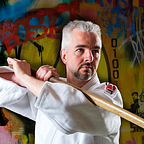Virtual Design Sprints in 4 Days or Less — Part III (the design)
Running design sprints is one of the most powerful tools you as a Product Manager, but how to run these now that we are working mostly from home? Here is a step by step approach to running a design sprint with your team in a virtual setting, and a free Miro template for you to run your own Design Sprint.
Art Museum
One of the beautiful aspects of a museum is the silence. You can admire the art without a voice over that interrupts your thought pattern. Well in some museums then. We will kick off the second day with the designs that you created as homework. By adding dots to the parts that you like we get a fast and concise insight in the best (understood) ideas.
To build upon that and avoid talking about stuff that is obvious we enter the speed critique. In this exercise the facilitator explains the designs to the group. So you don’t explain your own ideas! only at the end of the three minute round you have the opportunity to point out what they missed. The great thing is that it avoids talking about what is obvious and focusses on what stands out or is unclear.
This exercise is followed up with one where we identify our favourite concepts. This allow us to bring together the best parts from all the different designs. Another round of voting is used to create focus in the pile of ideas.
User Flow
Next we take all that input and design a user test flow. First individually, then we select the best one to turn into a story board.
Together we work on a detailed storyboard that will form the basis of our experiment. You can use sketching tools, wireframes, whatever you feel works well. We always seem to end up with a digital / paper prototype experiment but it is important to stress that there are other options as well. You could also
- create a landing page to gauge interest
- create a sign up page to test willingness to pay
- create a concierge service to manually perform all the tasks
- create an explainer video to test user expectation fit
- do many other things to test your assumptions
Physical sessions tend to go really fast with pre-printed templates, but that might not be the case in a virtual settings. So we will use Miro’s built-in template library for wireframing. That, combined with clever screenshots allowed us to build a prototype in roughly 2 hours that looked pretty impressive. We designed between 6 and 8 screens that showed a solution to the primary problem that our experts described. Done right? not quite.
Testing with real users
The final phase were a series of 5 customer interviews. This was done partially in parallel to speed up the process, but all followed the same pattern. Because we had prepared a series of questions per screen. Examples are:
- What is the first thing that grabs your attention?
- What would you click on and why?
- What do you think <feature> will do?
- How relevant is that information to you?
- Would you trust this data?
- Did you miss anything?
- What would you do on this screen
There is value in having a fixed set of questions because it will make the processing of the results easier. Open ended questions can be added to the process but should not be the core of it. If you run an experiment to “see what will happen” it will always be a success, since “something” will always happen.
The other big plus of coming up with a set of questions is the implicit need for the team to converge on what it is that we need to learn.
Bringing it all together
You now have a lot of insights and information. How can you keep track of all that and keep those associations between the different activities alive? As a facilitator we wrapped up all the insights for the team in a Lean UX canvas.
You can see that we gathered all that information during the design sprint and by putting it on a single A3/A4 sheet of paper we can “stick it to the wall” and make sure we don’t forget about it. It also has all the right facts to build a narrative when we are pitching for the next steps.
Which is actually worthwhile to spend another 15 minutes or so on. At the end of the design sprint we use the 5-bold steps to define the vision of our product, how to get there, what we need and what challenges we may need to overcome. Visually it looks something like this:
Alright, that was it for Part III. Have fun create amazing products and if you want to learn more about Product Management, subscribe to the blog.
